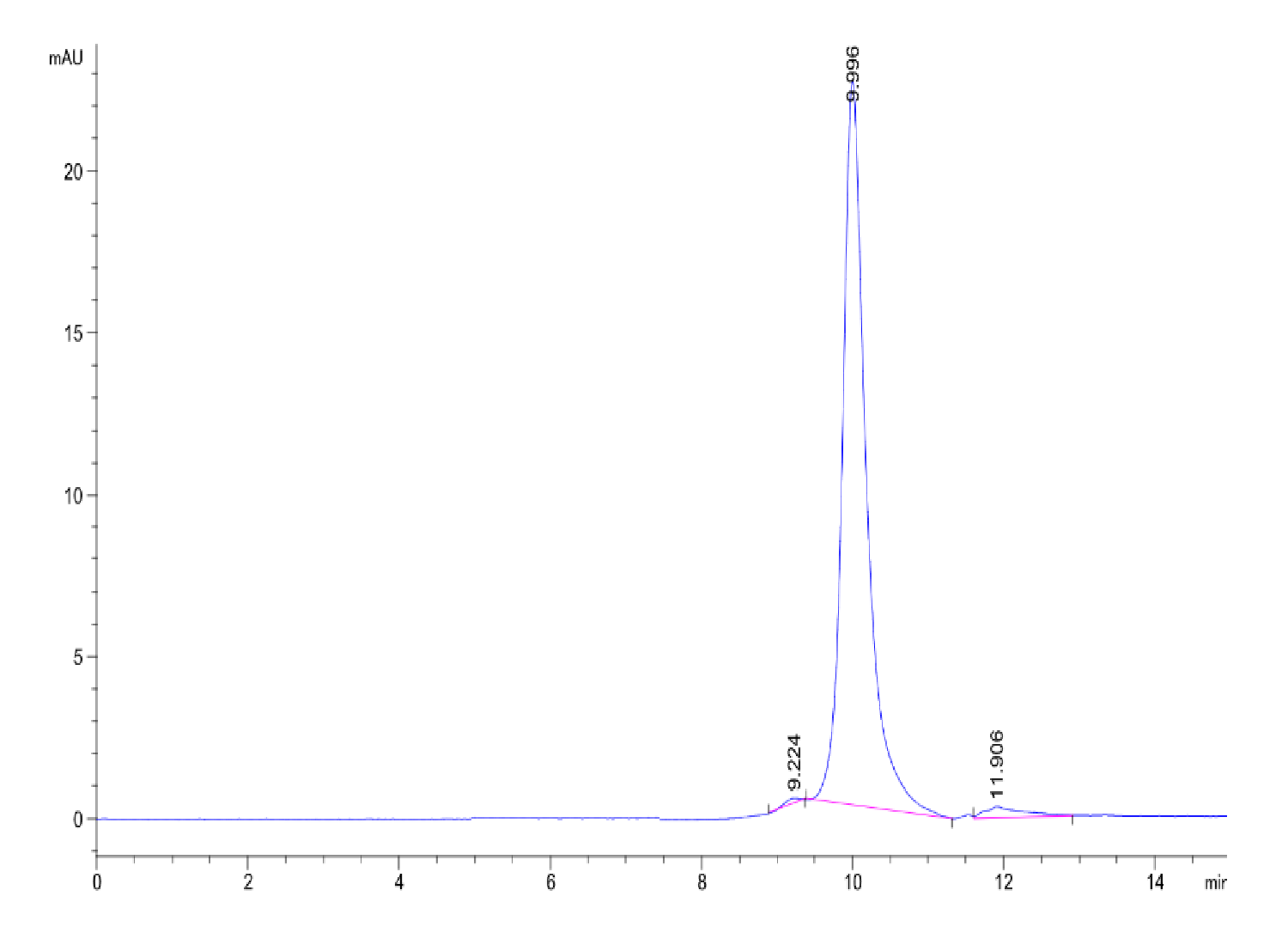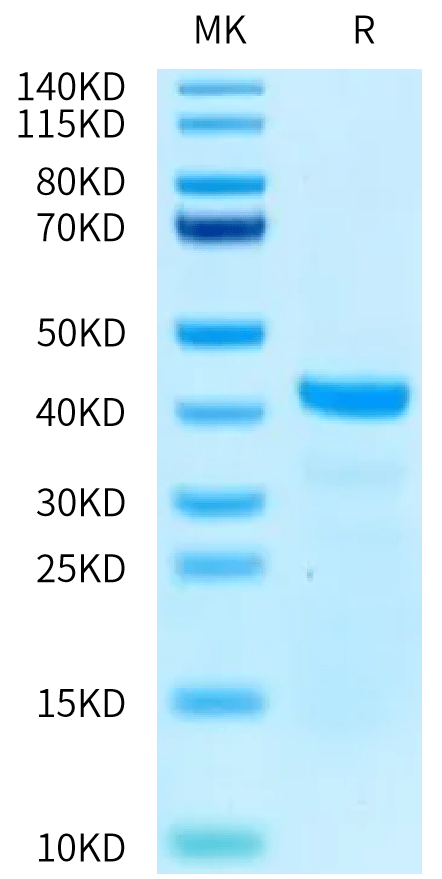| Weight | 1 lbs |
|---|---|
| Dimensions | 9 × 5 × 2 in |
| accession | P28482 |
| express system | Baculovirus-Insect Cells |
| product tag | C-His |
| purity | > 95% as determined by Tris-Bis PAGE;> 95% as determined by HPLC |
| background | Extracellular signal-regulated protein kinase 2 (ERK2) plays many vital roles in cellular signal regulation. Phosphorylation of ERK2 leads to propagation and execution of various extracellular stimuli, which influence cellular responses to stress. The final response of the ERK2 signaling pathway is determined by localization and duration of active ERK2 at specific target cell compartments through protein-protein interactions of ERK2 with various cytoplasmic and nuclear substrates, scaffold proteins, and anchoring counterparts. |
| molecular weight | The protein has a predicted MW of 42.91 kDa same as Tris-Bis PAGE result. |
| available size | 100 µg, 500 µg |
| endotoxin | Less than 1EU per μg by the LAL method. |
Human ERK2 Protein 2286
$300.00 – $1,000.00
Summary
- Expression: Baculovirus-Insect Cells
- Pure: Yes (HPLC)
- Amino Acid Range: Met1-Ser360
Human ERK2 Protein 2286
| protein |
|---|
| Size and concentration 100, 500µg and liquid |
| Form Liquid |
| Storage Instructions Valid for 12 months from date of receipt when stored at -80°C. Recommend to aliquot the protein into smaller quantities for optimal storage. Please minimize freeze-thaw cycles. |
| Storage buffer Shipped with dry ice. |
| Purity > 95% as determined by Tris-Bis PAGE |
| target relevance |
|---|
| Extracellular signal-regulated protein kinase 2 (ERK2) plays many vital roles in cellular signal regulation. Phosphorylation of ERK2 leads to propagation and execution of various extracellular stimuli, which influence cellular responses to stress. The final response of the ERK2 signaling pathway is determined by localization and duration of active ERK2 at specific target cell compartments through protein-protein interactions of ERK2 with various cytoplasmic and nuclear substrates, scaffold proteins, and anchoring counterparts. |
| Protein names Mitogen-activated protein kinase 1 (MAP kinase 1) (MAPK 1) (EC 2.7.11.24) (ERT1) (Extracellular signal-regulated kinase 2) (ERK-2) (MAP kinase isoform p42) (p42-MAPK) (Mitogen-activated protein kinase 2) (MAP kinase 2) (MAPK 2) |
| Gene names MAPK1,MAPK1 ERK2 PRKM1 PRKM2 |
| Protein family Protein kinase superfamily, CMGC Ser/Thr protein kinase family, MAP kinase subfamil |
| Mass 9606Da |
| Function Serine/threonine kinase which acts as an essential component of the MAP kinase signal transduction pathway. MAPK1/ERK2 and MAPK3/ERK1 are the 2 MAPKs which play an important role in the MAPK/ERK cascade. They participate also in a signaling cascade initiated by activated KIT and KITLG/SCF. Depending on the cellular context, the MAPK/ERK cascade mediates diverse biological functions such as cell growth, adhesion, survival and differentiation through the regulation of transcription, translation, cytoskeletal rearrangements. The MAPK/ERK cascade also plays a role in initiation and regulation of meiosis, mitosis, and postmitotic functions in differentiated cells by phosphorylating a number of transcription factors. About 160 substrates have already been discovered for ERKs. Many of these substrates are localized in the nucleus, and seem to participate in the regulation of transcription upon stimulation. However, other substrates are found in the cytosol as well as in other cellular organelles, and those are responsible for processes such as translation, mitosis and apoptosis. Moreover, the MAPK/ERK cascade is also involved in the regulation of the endosomal dynamics, including lysosome processing and endosome cycling through the perinuclear recycling compartment (PNRC); as well as in the fragmentation of the Golgi apparatus during mitosis. The substrates include transcription factors (such as ATF2, BCL6, ELK1, ERF, FOS, HSF4 or SPZ1), cytoskeletal elements (such as CANX, CTTN, GJA1, MAP2, MAPT, PXN, SORBS3 or STMN1), regulators of apoptosis (such as BAD, BTG2, CASP9, DAPK1, IER3, MCL1 or PPARG), regulators of translation (such as EIF4EBP1 and FXR1) and a variety of other signaling-related molecules (like ARHGEF2, DCC, FRS2 or GRB10). Protein kinases (such as RAF1, RPS6KA1/RSK1, RPS6KA3/RSK2, RPS6KA2/RSK3, RPS6KA6/RSK4, SYK, MKNK1/MNK1, MKNK2/MNK2, RPS6KA5/MSK1, RPS6KA4/MSK2, MAPKAPK3 or MAPKAPK5) and phosphatases (such as DUSP1, DUSP4, DUSP6 or DUSP16) are other substrates which enable the propagation the MAPK/ERK signal to additional cytosolic and nuclear targets, thereby extending the specificity of the cascade. Mediates phosphorylation of TPR in response to EGF stimulation. May play a role in the spindle assembly checkpoint. Phosphorylates PML and promotes its interaction with PIN1, leading to PML degradation. Phosphorylates CDK2AP2 (By similarity).; Acts as a transcriptional repressor. Binds to a [GC]AAA[GC] consensus sequence. Repress the expression of interferon gamma-induced genes. Seems to bind to the promoter of CCL5, DMP1, IFIH1, IFITM1, IRF7, IRF9, LAMP3, OAS1, OAS2, OAS3 and STAT1. Transcriptional activity is independent of kinase activity. |
| Catalytic activity BINDING 31..39; /ligand="ATP"; /ligand_id="ChEBI:CHEBI:30616"; /evidence="ECO:0000255|PROSITE-ProRule:PRU00159"; BINDING 54; /ligand="ATP"; /ligand_id="ChEBI:CHEBI:30616"; /evidence="ECO:0000255|PROSITE-ProRule:PRU00159" |
| Subellular location Cytoplasm, cytoskeleton, spindle. Nucleus. Cytoplasm, cytoskeleton, microtubule organizing center, centrosome. Cytoplasm. Membrane, caveola. Cell junction, focal adhesion. Note=Associated with the spindle during prometaphase and metaphase (By similarity). PEA15-binding and phosphorylated DAPK1 promote its cytoplasmic retention. Phosphorylation at Ser- 246 and Ser-248 as well as autophosphorylation at Thr-190 promote nuclear localization. |
| Structure Binds both upstream activators and downstream substrates in multimolecular complexes. This interaction inhibits its tyrosine-kinase activity. Interacts with ADAM15, ARHGEF2, ARRB2, DAPK1 (via death domain), HSF4, IER3, IPO7, NISCH, SGK1, and isoform 1 of NEK2. Interacts (via phosphorylated form) with TPR (via C-terminal region and phosphorylated form); the interaction requires dimerization of MAPK1/ERK2 and increases following EGF stimulation (PubMed:18794356). Interacts with MAP2K1 (PubMed:32721402). Interacts with DUSP6 (PubMed:32721402, PubMed:9596579). Interacts (phosphorylated form) with CAV2 ('Tyr-19'-phosphorylated form); the interaction, promoted by insulin, leads to nuclear location and MAPK1 activation. Interacts with MORG1, PEA15 and MKNK2 (By similarity). MKNK2 isoform 1 binding prevents from dephosphorylation and inactivation (By similarity). Interacts with DCC (By similarity). The phosphorylated form interacts with PML (isoform PML-4). Interacts with STYX. Interacts with CDK2AP2. Interacts with CAVIN4 (By similarity). Interacts with DUSP7; the interaction enhances DUSP7 phosphatase activity (PubMed:9788880). Interacts with GIT1; this interaction is necessary for MAPK1 localization to focal adhesions (By similarity). Interacts with ZNF263 (PubMed:32051553).; (Microbial infection) Interacts with HIV-1 Nef through its SH3 domain. |
| Post-translational modification Phosphorylated upon KIT and FLT3 signaling (By similarity). Dually phosphorylated on Thr-185 and Tyr-187, which activates the enzyme. Undergoes regulatory phosphorylation on additional residues such as Ser-246 and Ser-248 in the kinase insert domain (KID) These phosphorylations, which are probably mediated by more than one kinase, are important for binding of MAPK1/ERK2 to importin-7 (IPO7) and its nuclear translocation. In addition, autophosphorylation of Thr-190 was shown to affect the subcellular localization of MAPK1/ERK2 as well. Ligand-activated ALK induces tyrosine phosphorylation. Dephosphorylated by PTPRJ at Tyr-187. Phosphorylation on Ser-29 by SGK1 results in its activation by enhancing its interaction with MAP2K1/MEK1 and MAP2K2/MEK2. DUSP3 and DUSP6 dephosphorylate specifically MAPK1/ERK2 and MAPK3/ERK1 whereas DUSP9 dephosphorylates a broader range of MAPKs. Dephosphorylated by DUSP1 and DUSP2 at Thr-185 and Tyr-187 (By similarity) (PubMed:16288922).; ISGylated.; Ubiquitinated by TRIM15 via 'Lys-63'-linked ubiquitination; leading to activation. Deubiquitinated by CYLD. |
| Domain Th |
| Target Relevance information above includes information from UniProt accession: P28482 |
| The UniProt Consortium |
Data
 |
| The purity of Human ERK2 is greater than 95% as determined by SEC-HPLC. |
 |
| Human ERK2 on Tris-Bis PAGE under reduced condition. The purity is greater than 95%. |
Publications
Publications
| pmid | title | authors | citation |
|---|---|---|---|
| We haven't added any publications to our database yet. | |||
Protocols
| relevant to this product |
|---|
Documents
| # | ||
|---|---|---|
| Please enter your product and batch number here to retrieve product datasheet, SDS, and QC information. | ||














